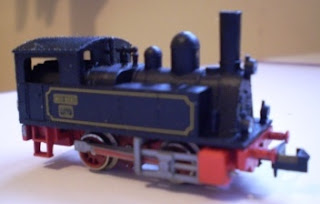Two related happenings at ExpoNG led to this. Firstly I looked for some reasonably priced PECO O-16.5 pointwork, but unable to gain any mates-rates prices and working out that even on one of my usual four point plans it was going to cost me over fifty quid... I don't have fifty quid. Secondly Laurie Maunder presented me with a DVD showing the build of a small layout that he constructed in the 70's. This sprung me into action. I didn't have fifty quid, but I did have some copperclad sleepers and some scrap rail left over from Llynfordd. If you ask ten modellers how they build track you will get ten different answers; this is my take on it. A lot of people say they can't build points - that's bollocks. If you can cut plasticard and solder wire onto rail, then you can do this. Tools: hacksaw,pliers, iron, big-ish file, flat needle file, wet and dry paper, solder ordinaire, flux, bit of wood, clamp.
A PECO small radius point was borrowed and marked out on paper. The paper then glued in the corners only to a flat piece of wood. Sleepers cut and laid with a tiny drop of UHU at 3' (21mm) centres. Two bits of rail were put together for the nose. Basically you file a flat on the inside edge of the straight rail (5mm) taking the 'foot' back a little further and the same with the splice rail, only angled to a point. Lay them on the plan at the angle required (here 1:4) and solder together.

Quick word on soldering: CLEAN everything! Polish the bottom of the rail and the copper sleepers. And use flux. I still use paste flux applied with a cocktail stick. Tin the sleepers with a light coat of solder, and fix to sleepers in position. Wipe the flux off and clean up with a file.

Straight stock rail: Cut to length, mark where the tiebar will go and file a notch (5-10mm)down to just below the web. Then gently file into this notch, in this case L to R so it graduates and again take the foot (if you're using flatbottom) back a little further.

CLEAN rail and sleepers. Tin sleepers and lay in position straight,square and in gauge with the pre-laid nose rail. Quick wipe of flux and solder on the outside. Wipe as before.
This is not pretty. It's not finescale. But it does work. Half the layouts in the history sidebar top right used this method with no ill effects. You don't need a set of fancy gauges. The 14mm one I used for the 7mm NG layout was the earth pin off a 13 apm plug with two notches cut in it and a piece of copperclad sleeper for the flangeways. You just need simple spacers. More anon.
 Like any self-respecting 60's/70's schoolboy I was brought up on Saturday afternoon Airfix kits and Humbrol Enamels. Then 15+ years go,almost overnight, and largely due to comments in Iain Rice's wagon books I switched to Acrylics; water-based, less smell, quick drying. After Warley and conversations with Geoff Taylor and Ian Rathbone I questioned this move. They both unreservedly use Humbrol Enamel and get excellent results especially with a bow-pen. Bob Fridd whose work I admire also is a fan of the smelly stuff as is Alan Brackenborough.
Like any self-respecting 60's/70's schoolboy I was brought up on Saturday afternoon Airfix kits and Humbrol Enamels. Then 15+ years go,almost overnight, and largely due to comments in Iain Rice's wagon books I switched to Acrylics; water-based, less smell, quick drying. After Warley and conversations with Geoff Taylor and Ian Rathbone I questioned this move. They both unreservedly use Humbrol Enamel and get excellent results especially with a bow-pen. Bob Fridd whose work I admire also is a fan of the smelly stuff as is Alan Brackenborough.




















 CLEAN rail and sleepers. Tin sleepers and lay in position straight,square and in gauge with the pre-laid nose rail. Quick wipe of flux and solder on the outside. Wipe as before.
CLEAN rail and sleepers. Tin sleepers and lay in position straight,square and in gauge with the pre-laid nose rail. Quick wipe of flux and solder on the outside. Wipe as before.






